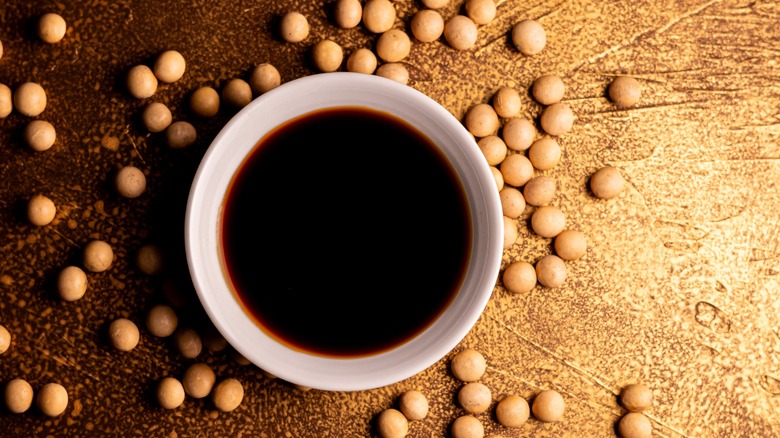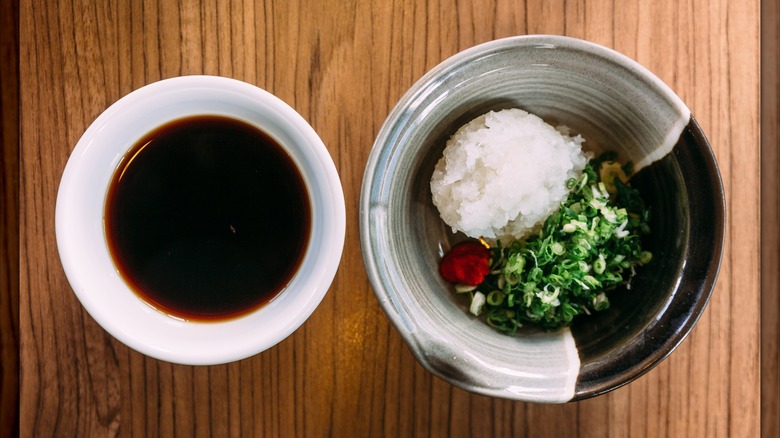What Makes Ponzu Different From Soy Sauce?
When browsing through the aisles of a Japanese grocer, an Asian market, or even the "international" aisle of your local supermarket chain, you may be struck by the vast array of unique sauces available to you -– each one representing something quintessential about the region's culinary practices. Japan is a country replete with a diverse range of cuisine, ranging from sushi and sashimi (yes, there is a difference) to delicious gyoza and okonomiyaki. And it seems that for every dish there's a corresponding sauce to enhance it.
Two standout sauces in the culinary culture of Japan are soy sauce and ponzu sauce. But you may have encountered one slight problem when looking at the two –- they look awfully similar. In fact, if you didn't know any better, you might confuse one for the other. But don't be mistaken; soy sauce and ponzu sauce are two distinct sauces that each have their own strengths and uses in the kitchen. It's worth your time to have both, but first let's break down what each sauce is, and how you can best use it.
Soy sauce: a preeminent Japanese condiment
Soy sauce, above all other Japanese sauces, has seemingly enjoyed the most fame and name recognition in the United States and much of the broader everyday culinary sphere. Noted for its rich, salty, umami flavor, this sauce works wonders in meat dishes such as sticky steak bites, and can even be the secret ingredient to elevate scrambled eggs to unprecedented heights. Aside from these uses, soy sauce can be used in soup, noodles, and fried rice dishes and can also be used as a marinade ingredient or just a standard dipping sauce. Needless to say, soy sauce is a fairly multipurpose ingredient, so what's in it that makes it such a marvel?
The ingredient list for regular soy sauce is pretty short and direct –- most soy sauces are made with a base of fermented soybeans alongside water, salt, and usually grain. The soybeans and grains are combined into a paste and left to ferment, traditionally for a period of six months or more. Once fermented, the product is pressed, releasing the dark, briny byproduct that you know as soy sauce. Typically, the longer the product ferments, the darker the sauce will be, usually inheriting some sweeter notes atop its umami and salty foundation.
Ponzu is distinct, but not entirely removed from soy sauce
Soy sauce and ponzu sauce can be mistaken for each other by the uninitiated based on their similar color and presentation. But if you dig just a bit below a surface-level analysis, you'll find that these two are related but entirely independent entities. In the case of ponzu sauce, you'll find that there are some ingredients and qualities contained in it that simply don't exist in soy sauce. As a result, ponzu sauce has carved its own niche in Japanese cuisine and serves its own unique purposes.
Unlike its soy-based counterpart, ponzu is a citrus-based sauce, usually made from the yuzu fruit (although the exact fruit can vary). Typically, ponzu also contains mirin, rice vinegar, and bonito flakes, giving you a sauce with plenty of zing backed up by a base of vinegary, umami flavor similar to soy sauce. Confusion might arise, however, when you encounter "ponzu shoyu" – ponzu sauce that also contains soy sauce. Both regular ponzu and ponzu shoyu can be referred to as ponzu sauce, so the best course of action is likely to simply check the ingredients list to differentiate the two. In terms of utility, ponzu offers a fresher, tangier taste to noodles, meats, and fish dishes compared to soy sauce and can also be an excellent ingredient in marinades in its own right. So, between soy sauce and ponzu, which one should you opt for? Assuming you're not averse to any ingredients in either, grab both and experience the wonderful differences for yourself!


